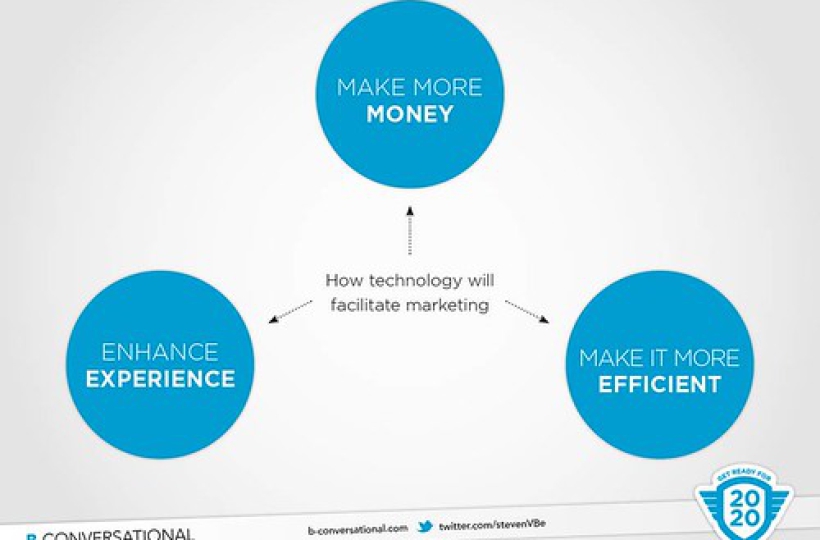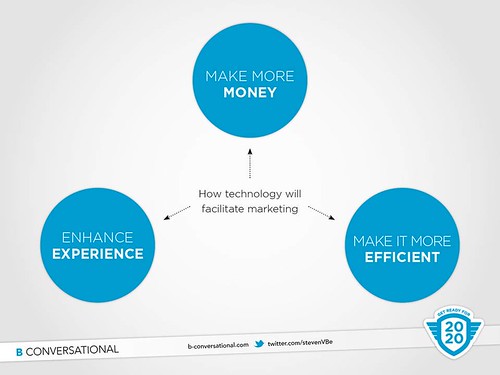6 cases where marketing and technology form a perfect blend

For quite some time now, I’ve felt that the cross between a marketing and an IT manager makes for a pretty interesting profile. In one of my previous posts I described the three dimensions of marketing in the future: extreme customer-centricity, selling without selling and, last but not least, technology. More and more pundits are predicting a shift from IT budget to marketing budget and for most marketers this represents a new challenge. At a time when many marketers are starting to understand the dynamics of social media, a new trend emerges: understanding technology, data and the opportunities it creates.
There are three dimensions in which technology can benefit marketing.
- Continue to improve the customer experience: new technology can further enhance the customer experience. Technology can bring the kind of innovation that wows the customer.
- Increase efficiency: technology can make processes more efficient. For instance, thanks to technology, service can evolve towards a self-service environment where the customer himself is able to solve problems faster and more efficiently. This would improve customer satisfaction and cut costs.
- Help generate more revenue: technology can make your product more relevant to the average consumer; in turn, more relevance makes customers want to buy more. Technology makes the process more efficient for the customer.
I will now outline a number of cases to describe how companies are already capitalizing on these dimensions.
Case 1: MyMagic+ by Disney
Mid-2012, Disneyworld introduced a new holiday management system for the visitors at their theme parks. On arrival, visitors to the Disney theme parks in Orlando are given an electronic bracelet that not only contains their credit card data but also acts as a room key and a theme-park ticket. Guests can enter their favorite attractions and are invited to try them when they are not so busy. The objective is to enhance the customer experience. All of a sudden, Cinderella greets your children by name because the magic bracelet displays the info as you approach her. And if it happens to be your birthday, the theme park characters will congratulate you.
Apart from a service upgrade, the bracelet also offers other advantages. Buying products and having them delivered to your room is easy and quick. Until now, this came with a lot of administrative formalities for both guests and staff; thanks to MyMagic+, the process is now fully automatic. Obviously Disney is also hoping the system will inspire their visitors to spend more. The possibilities for Disney are virtually limitless.
What’s more, Disney applies new technology to make the Disney characters seem even more alive. Mickey can talk now and he’s happy to answer your every question. This is clearly a technological application aimed solely at enhancing the customer experience.
Case 2: Buying online through Twitter thanks to Amex
American Express customers can now make payments via Twitter simply by syncing their card with their Twitter account. The selected items are bought by including a special purchase hashtag and Amex then confirms your purchase with a tweet. The sale is made final if the card holder retweets the tweet inside 15 minutes. Right now paying via tweets is only possible in the US for a limited range of products. There are just a few manufacturers offering products for sale through tweets. Among the products currently available are the XBox and Amazon’s Kindle Fire HD. The entire transaction takes place on Twitter: the offer, the purchase and the confirmation of the sale, enabling consumers for the very first time to go through the entire purchase process via Twitter.
Case 3: Dynamic price setting by Amazon
Amazon is the undisputed champion of automatic price updates. Every hour, the price of some 2 million products is adjusted on the Amazon site .The price of some products is updated up to 9 times a day. Thanks to Amazon, products no longer have a fixed price: a product falls within a certain price range and the actual price is set depending on the context of the day (of the hour).
Amazon runs algorithms hat measure the popularity of the various products while also monitoring the prices of the competition. The goal is to offer the best prices at all times. Amazon is a company that depends on large volumes sold at low margins. This way, the sharp prices serve a double purpose: on the one hand they attract customers but on the other hand they also deter competitors. After all, narrow margins make for an unattractive market. Amazon has been using this principle for years, but now other retailers are starting to copy it as well.
In addition, the data they acquire is not only used to set the price; they are also masters at direct marketing. Based on their customers’ clicking behavior, Amazon is able to send them frighteningly relevant promotions.
Case 4: Burberry personalizes clothing items through an embedded chip
During London Fashion Week, Burberry presented new technology enabling consumers to order items from the new collection immediately after featuring on the catwalk. Through the online order, Burberry collects customer data that are stored in a computer chip embedded in the purchased items. The data collected on the chip are used to personalize interactive content and to personalize the clothing items by adding a nameplate.
Burberry puts a whole new spin on personalization by adding new technology to its clothing articles and accessories. The chip activates short videos detailing the history of the product. The video also shows how the buyer’s name is engraved on a golden nameplate.
When consumers visit the flagship store in London with such a chip, the store will recognize them. During their visit, personalized content is displayed on large screens and interactive mirrors.
Case 5: Synchronizing a second screen with the TV screen
The Japanese telecom company NTT is currently experimenting with the synchronization of content on TV with content on your iPad. The challenge for developers of TV commercials will consist in providing enriching content off-screen instead of on the TV screen.
NTT’s technology is based on digital watermarks that synchronize the image on the TV screen with that of your iPad, which now displays augmented reality or another type of additional content. NTT’s objective is to improve the conversion rate of TV commercials. The company hopes the additional content on the second screen will guide consumers to their webshop.
Case 6: A billboard that extracts water from the air
It’s a billboard for a school for engineers and it’s located in Peru. Instead of simply promoting the school, the billboard also provides tangible added value by producing fresh water for the locals. The Lima region frequently suffers from a shortage of water so this action creates a significant degree of added value.
The Lima region is exceptionally dry but the average humidity is 98%. The billboard contains five generators able to convert the high humidity into clear and free potable water for the local population.
Marketing 2020
Technology is undeniably becoming an integral part of modern marketing. Modern marketers are making the most of new technologies to create added value for the customer. Check out the presentation below for my detailed vision of the role of technology in marketing.



